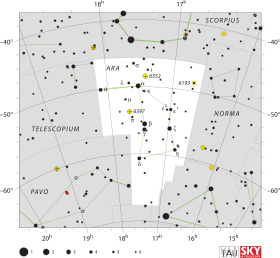Astrométrie
Vitesse radiale
+4,54 ± 0,21 km /s [ 5]
Mouvement propre
μ α mas /a [ 1] μ δ mas /a [ 1]
Parallaxe
47,704 5 ± 0,136 8 mas [ 1]
Distance
20,962 ± 0,060 pc al [ 1]
Magnitude absolue
+3,10[ 6]
Désignations
λ Ara,
HR 6569,
HD 160032,
HIP 86486,
CD -49 11616,
CPD -49 10162,
GJ 86486,
GJ 9597,
NLTT 45187,
NSV 23218,
SAO 228257
[ 9] modifier
Lambda Arae (λ Ara / λ Arae) est une étoile de la constellation australe de l'Autel . Elle est visible à l'œil nu et sa magnitude apparente est de 4,77[ 2] parallaxe annuelle par le satellite Gaia a.l. pc vitesse radiale héliocentrique de +4,5 km/s [ 5]
Lamba Arae est une étoile jaune-blanc de la séquence principale de type spectral F4 V [ 3] température de surface de 6 636 K [ 7] celle du Soleil [ 7] rayon solaire [ 5] lumineuse que le Soleil [ 7] spectroscopiques qui laissent à penser qu'elle serait une binaire constituée de deux étoiles jumelles[ 8] , [ 10]
Le télescope spatial Spitzer a mis en évidence un excès d'émission dans l'infrarouge en provenance de Lambda Arae à une longueur d'onde de 70 μm . Cela suggère que l'étoile pourrait être orbitée par un disque de débris , localisé à un distance supérieure à 15 ua [ 11]
↑ a b c d e et f
(en) A. G. A. Brown et al. Gaia collaboration), « Gaia Early Data Release 3 : Summary of the contents and survey propertiesAstronomy & Astrophysics vol. 649, mai 2021 , article no A1 (DOI 10.1051/0004-6361/202039657 Bibcode 2021A&A...649A...1G arXiv 2012.01533 Notice Gaia EDR3 pour cette source sur VizieR .
↑ a b c et d (en) H. L. Johnson et al. UBVRIJKL photometry of the bright stars », Communications of the Lunar and Planetary Laboratory vol. 4, no 99, 1966 (Bibcode 1966CoLPL...4...99J ↑ a et b (en) R. O. Gray et al. Contributions to the Nearby Stars (NStars) Project: spectroscopy of stars earlier than M0 within 40 pc-The Southern Sample », The Astronomical Journal vol. 132, no 1, juillet 2006 , p. 161–170 (DOI 10.1086/504637 Bibcode 2006AJ....132..161G arXiv astro-ph/0603770 ↑ (en) N. N Samus' , E. V. Kazarovets et al. General Catalogue of Variable Stars: NSV and supplement Astronomy Reports vol. 61, no 1, 2017 , p. 80 (DOI 10.1134/S1063772917010085 Bibcode 2017ARep...61...80S ↑ a b c et d
(en) A. G. A. Brown et al. Gaia collaboration), « Gaia Data Release 2 : Summary of the contents and survey propertiesAstronomy & Astrophysics vol. 616, août 2018 , article no A1 (DOI 10.1051/0004-6361/201833051 Bibcode 2018A&A...616A...1G arXiv 1804.09365 Notice Gaia DR2 pour cette source sur VizieR .
↑ (en) J. Holmberg , B. Nordstrom et J. Andersen , « The Geneva-Copenhagen survey of the solar neighbourhood. III. Improved distances, ages, and kinematics », Astronomy & Astrophysics vol. 501, no 3, juillet 2009 , p. 941–947 (DOI 10.1051/0004-6361/200811191 Bibcode 2009A&A...501..941H arXiv 0811.3982 ↑ a b c d e f g h et i (en) R. Earle Luck , « Abundances in the Local Region. III. Southern F, G, and K Dwarfs », The Astronomical Journal vol. 155, no 3, mars 2018 , p. 31, article no 111 (DOI 10.3847/1538-3881/aaa9b5 Bibcode 2018AJ....155..111L ↑ a et b (en) K. Fuhrmann et al. Evidence for the nearby F4V star λ Ara as a binary system », Monthly Notices of the Royal Astronomical Society vol. 415, no 2, août 2011 , p. 1240–1243 (DOI 10.1111/j.1365-2966.2011.18764.x Bibcode 2011MNRAS.415.1240F ↑ (en) * lam Ara -- High proper-motion Star sur la base de données Simbad Centre de données astronomiques de Strasbourg .↑ (en) K. Fuhrmann et al. Multiplicity among Solar-type Stars », The Astrophysical Journal vol. 836, no 1, février 2017 , p. 23, article no 139 (DOI 10.3847/1538-4357/836/1/139 Bibcode 2017ApJ...836..139F ↑ (en) S. M. Lawler et al. Explorations Beyond the Snow Line: Spitzer/IRS Spectra of Debris Disks Around Solar-type Stars », The Astrophysical Journal vol. 705, no 1, novembre 2009 , p. 89-111 (DOI 10.1088/0004-637X/705/1/89 Bibcode 2009ApJ...705...89L arXiv 0909.0058
Liens externes
